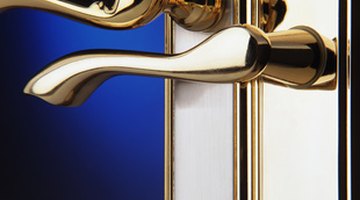How to Repair a Storm Door Latch
A storm door latch is a simple piece of metal that moves in and out when you depress a button or turn a lever. It allows you to gain access to or exit a house. When a latch no longer works, the door does not function as intended.

The most common problem with a latch is the strike plate, which is attached to the door frame directly opposite the latch. The latch fits into a hole in the strike plate to keep the door from just blowing open. When the strike plate becomes damaged or misaligned, the latch cannot connect with the strike plate.
Things You Will Need
- Variable speed drill
- Pencil
- Box knife
- Shim
Tip
A storm door latch is the same as other door latches. You can use these steps to fix any door latch that you are having problems with.
Latch Strike Plate Too High or Too Low
-
Remove the strike plate on the jamb side of the storm door with the drill. Two screws hold the strike plate in place.
-
Kneel down to eye level with the storm door latch. Pull the door open towards you, and observe where the bottom of the latch is in correlation with the strike plate hole. Place a pencil mark on the edge of the strike plate hole where the bottom of the latch is.
-
Hold the strike plate back in its original position, and check if the bottom of the strike plate is higher than the pencil mark. The latch will not fit into the strike plate hole when the bottom of the strike plate is too high. The same thing applies if the strike plate is too low.
-
Adjust the height of the strike plate up or down based on the location of the pencil mark. Place a screw on the end of the drill bit; hold the strike plate in its new position, and insert the screw through the top anchor hole on the strike plate, before inserting the bottom screw. Test the door to see if it will latch.
Latch Strike Plate Misaligned
-
Loosen the latch strike plate screws with the drill, but do not remove the screws from the strike plate.
-
Slide the strike plate to the right, and tighten the screws back down. Test the storm door to see if it will stay latched shut.
-
Loosen the latch plate screws again, and move the latch to the left. Tighten the screws, and test the storm door. Sometimes the strike plate latch becomes misaligned with the strike plate hole in the doorjamb. When the strike plate becomes misaligned, the storm door will not latch.
Sunken Latch Strike Plate
-
Cut two small pieces of wood shim that will fit behind the top and bottom portion of the latch strike plate, which is above and below the strike plate hole.
-
Remove the screws from the latch strike plate with the drill, and remove the strike plate.
-
Place one of the pieces of wood shim behind the top portion of the latch strike plate, and insert and tighten a screw through the top of the latch strike plate and through the wood. Slide the second piece of wood shim under the bottom of the latch strike plate, insert and tighten the bottom screw.
The Drip Cap
- A storm door latch is a simple piece of metal that moves in and out when you depress a button or turn a lever.
- It allows you to gain access to or exit a house.
- Test the storm door to see if it will stay latched shut.
- Sometimes the strike plate latch becomes misaligned with the strike plate hole in the doorjamb.
- Cut two small pieces of wood shim that will fit behind the top and bottom portion of the latch strike plate, which is above and below the strike plate hole.
- Slide the second piece of wood shim under the bottom of the latch strike plate, insert and tighten the bottom screw.
References
Writer Bio
Based in Oklahoma City, Debbie Tolle has been working in the home-improvement industry since 2001 and writing since 1998. Tolle holds a Master of Science in psychology from Eastern Illinois University and is also a Cisco-certified network associate (CCNA) and a Microsoft-certified systems engineer (MCSE).
Photo Credits
- brass door handle image by enens from Fotolia.com
- brass door handle image by enens from Fotolia.com
More Articles



